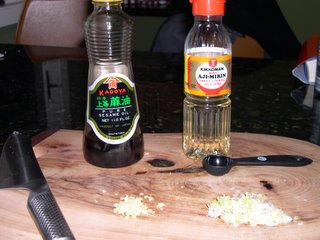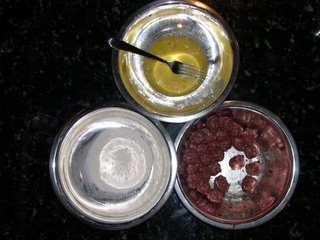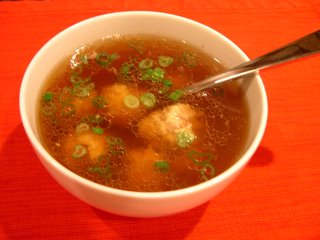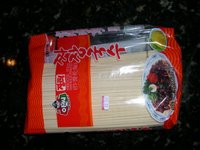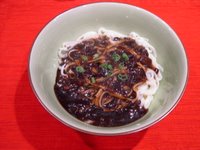Korean Barbecue - First Try
When people think of Korean food, they often think of Korean Barbecue - aka Bulgogi. We usually pick up the pre-marinated meat at the Korean grocery but I decided to try making it myself to see how that went.
It was different than the store-made because there was a lot less marinade and it was only in the marinade for an hour so it had less time ito absorb the flavors. Ray said that he preferred it and I have to agree with him on that because it does have a better balance between the taste of the meat and the marinade.
Here's the recipe for the first attempt. I plan on trying other recipes to see what else I can come up with and with any luck will some day get to spy on Ray's mom as she cooks.
4t sugar
1 1/2 pounds boneless rib steak sliced into 1/8 inch thin slices (ask your butcher to slice it for you.)
Mix the beef and sugar together - I found it easiest to just sprinkle a little sugar on each slice as I worked through the pile of meat separating them. Let this rest for 2 minutes.
While the beef/sugar are resting, mix together:
1/4 c soy sauce
3 garlic cloves chopped fine
3 scallions cut into 1 inch pieces
1/4 t pepper
1t sesame oil
Add this mixture to the the meat and toss to integrate the flavors. Cover and let stand at room temperature for a minimum of 1 hour - or overnight in the refrigerator.
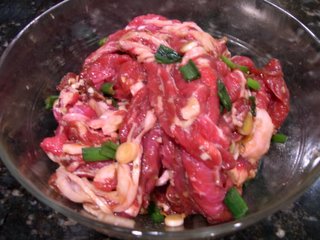 When you are ready to eat you can grill it or as we just just cook it in a cast iron skillet.
When you are ready to eat you can grill it or as we just just cook it in a cast iron skillet.
This is Ray helping cook the bulgogi.
Along with the bulgogi I made pan fried potatoes - for these you just peel potatoes and slice into 1/4 inch thick rounds. Put them in a pan with water to cover and cook for about 4 minutes. Strain.
In a separate bowl combine 1 c flour and 2 c water with some salt and pepper.
On a plate, put 1 c additional flour. Coat the potatoes with flour and let sit on the plate as you heat 1 1/2 T of vegetable oil until it just starts to smoke. Dredge the potatoes in the flour-water mixture and put into the hot oil. Fry 3 minutes and turn. Add oil if necessary and fry another 3 minutes.
I don't have the many additional dishes that you would normally get at a restaurant but served it with rice, lettuce, ssamjang, kimchi, the potatoes and a dipping sauce.

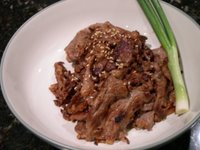
When people think of Korean food, they often think of Korean Barbecue - aka Bulgogi. We usually pick up the pre-marinated meat at the Korean grocery but I decided to try making it myself to see how that went.
It was different than the store-made because there was a lot less marinade and it was only in the marinade for an hour so it had less time ito absorb the flavors. Ray said that he preferred it and I have to agree with him on that because it does have a better balance between the taste of the meat and the marinade.
Here's the recipe for the first attempt. I plan on trying other recipes to see what else I can come up with and with any luck will some day get to spy on Ray's mom as she cooks.
4t sugar
1 1/2 pounds boneless rib steak sliced into 1/8 inch thin slices (ask your butcher to slice it for you.)
Mix the beef and sugar together - I found it easiest to just sprinkle a little sugar on each slice as I worked through the pile of meat separating them. Let this rest for 2 minutes.
While the beef/sugar are resting, mix together:
1/4 c soy sauce
3 garlic cloves chopped fine
3 scallions cut into 1 inch pieces
1/4 t pepper
1t sesame oil
Add this mixture to the the meat and toss to integrate the flavors. Cover and let stand at room temperature for a minimum of 1 hour - or overnight in the refrigerator.
 When you are ready to eat you can grill it or as we just just cook it in a cast iron skillet.
When you are ready to eat you can grill it or as we just just cook it in a cast iron skillet.
This is Ray helping cook the bulgogi.
Along with the bulgogi I made pan fried potatoes - for these you just peel potatoes and slice into 1/4 inch thick rounds. Put them in a pan with water to cover and cook for about 4 minutes. Strain.
In a separate bowl combine 1 c flour and 2 c water with some salt and pepper.
On a plate, put 1 c additional flour. Coat the potatoes with flour and let sit on the plate as you heat 1 1/2 T of vegetable oil until it just starts to smoke. Dredge the potatoes in the flour-water mixture and put into the hot oil. Fry 3 minutes and turn. Add oil if necessary and fry another 3 minutes.
I don't have the many additional dishes that you would normally get at a restaurant but served it with rice, lettuce, ssamjang, kimchi, the potatoes and a dipping sauce.


